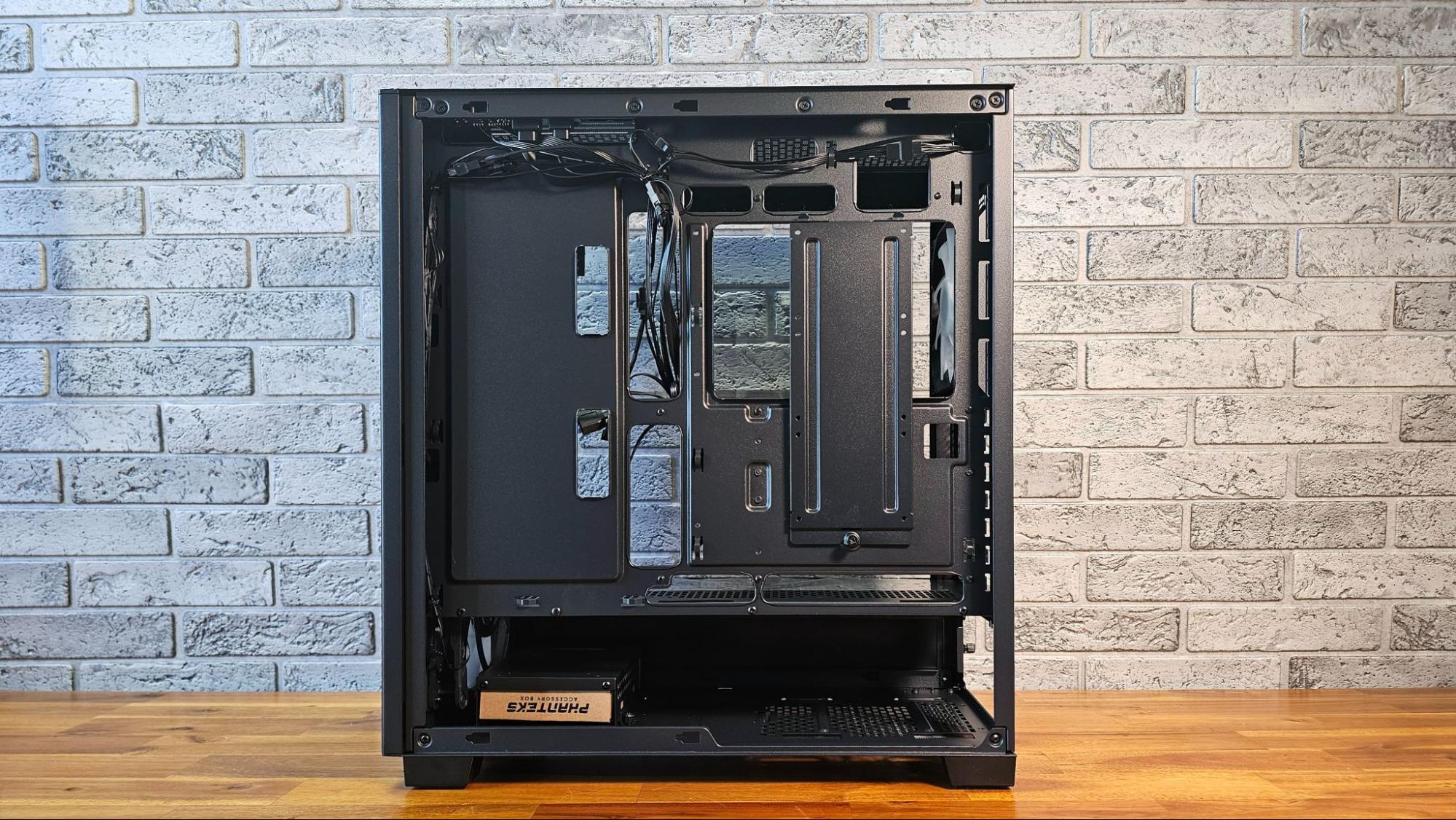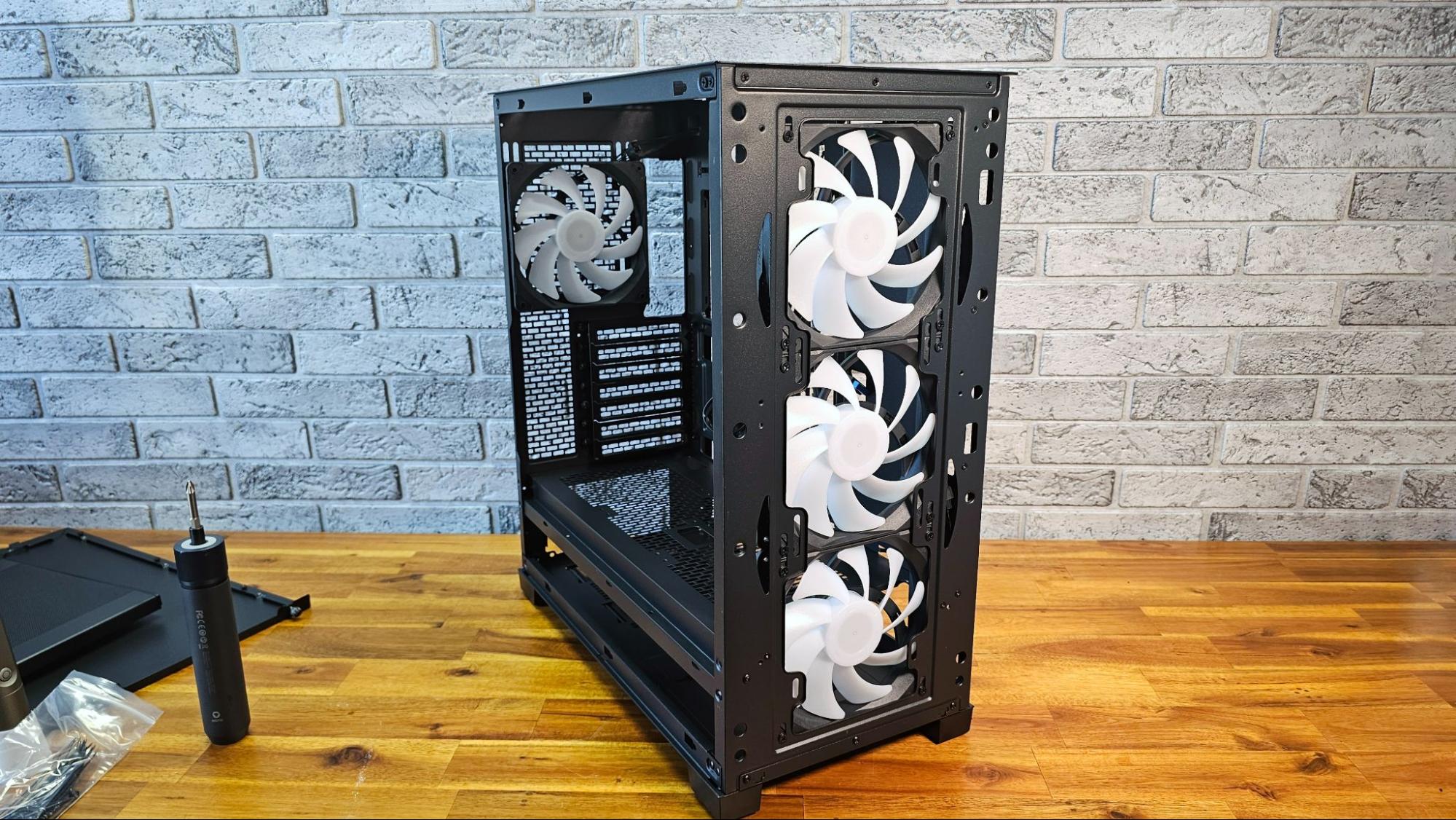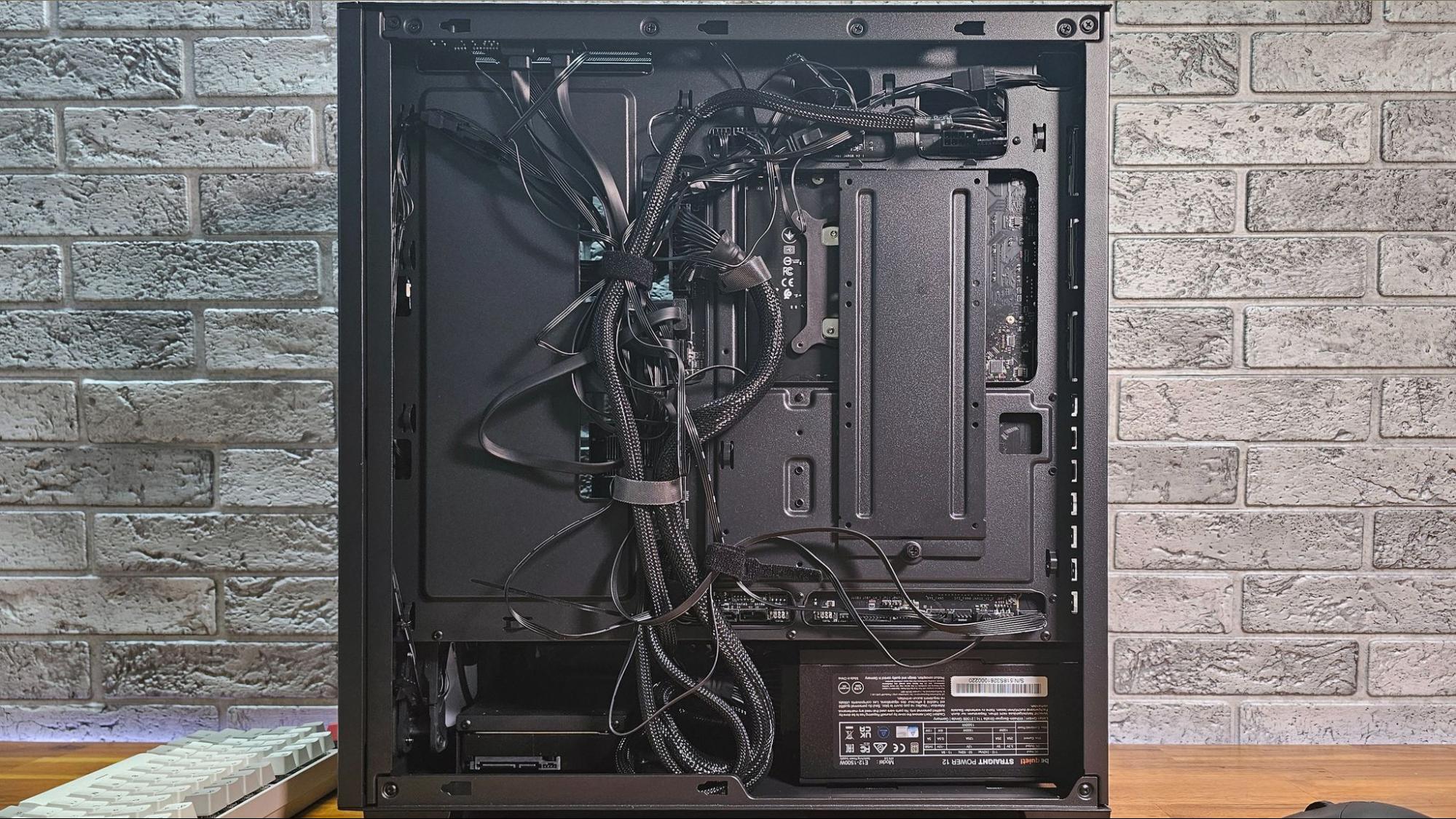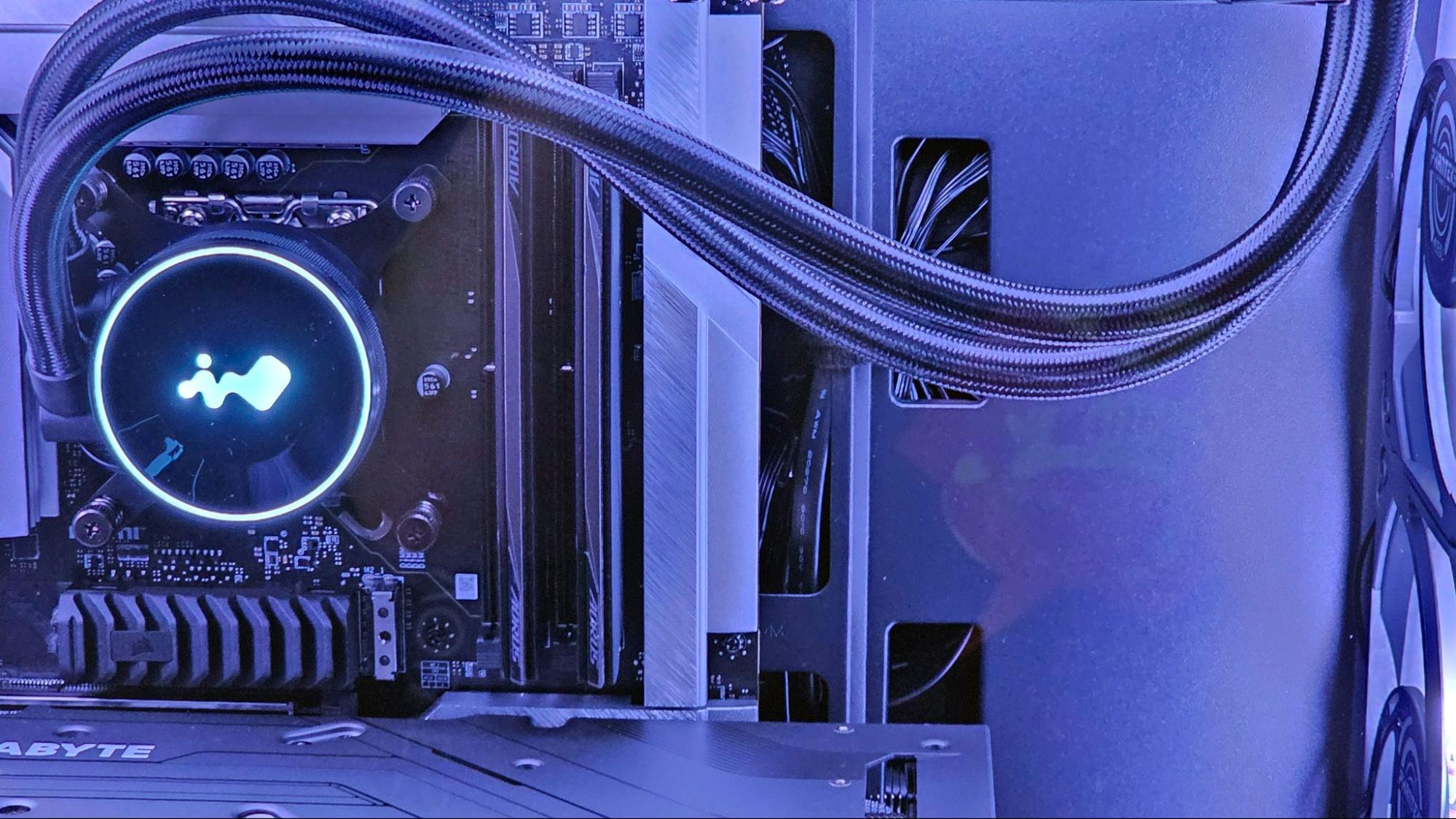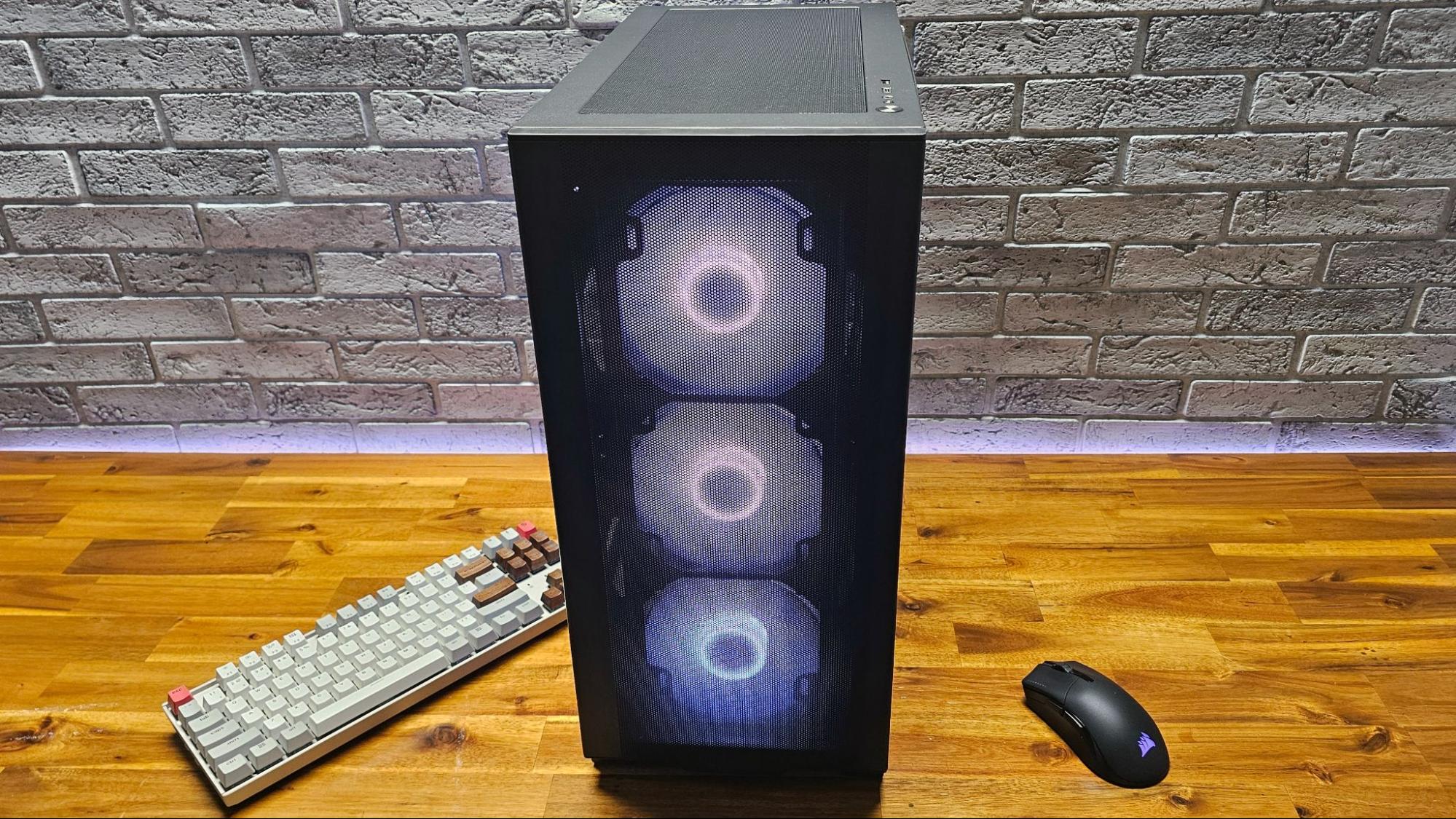Hands-On with Phanteks' XT Pro Ultra PC case: Modern features with lots of airflow and RGB out of the box

If you asked me what features I'd expect in a $80 budget PC case, I definitely wouldn't suggest four 140mm ARGB fans, a tempered glass side panel, and support for those brand-new rear connector motherboards. But that's what Phanteks delivers with its XT Pro Ultra case. And while the company definitely cut some corners to deliver all this (in your choice of black or white) for just $79.99, there are no sharp edges or cheap-feeling buttons or drive bays here.
My primary gripe is that there's no removable front dust filter (though there is one at the top and the bottom). There also aren't any rubber grommets around the cable cutouts, but the edges are finished nicely enough that I didn't really miss them. And with room for large, high-end components, a surprising amount of off-board storage (up to five 2.5-inch drives), and four of Phanteks' M25-140 D-RGB fans (which cost almost $50 on their own), there's very little to complain about here.
The Phanteks XT Pro Ultra doesn't deliver any groundbreaking features, but if you're after a modern, airflow-focused PC case on a budget, this is the best option to come across our test bench in a long time. Just looking at its features and specs, the XT Pro Ultra has a decent chance of earning a spot on our Best PC cases list. But we'll have to delve deeper into its features and build a system in it, which we'll do below, to see if it truly stands out, or if Phanteks made too many sacrifices to keep the costs low.
Phanteks XT Lineup
The XT Pro Ultra is part of a lineup of three new XT cases from Phanteks, which all seem to be based around the same internal frame. The entry-level XT Pro at just $59.99 has a single non-RGB 120mm exhaust fan and two top USB-A ports – it's offered only in black. The XT Pro Ultra we're looking at here steps up to four larger 140mm RGB fans, and swaps one of its USB-A ports for a USB-C. There's still only two USB ports on the top IO, though.
The Phanteks XT View (which doesn't seem to be available in the U.S. yet) has glass on the front and sides and three 120mm RGB fans, plus a light strip that runs along the top of the PSU shroud (much like on the Phanteks Eclipse G360A). All of these cases feature cutouts on the board mounting area for rear-connector / MG-RC motherboards, and all but the $60 XT Pro are offered in black or white.
Phanteks XT Pro Ultra Specs
| Type | Mid Tower |
| Motherboard Support | Micro ATX, Mini-ITX, E-ATX (up to 280mm) |
| Dimensions (HxWxD) | 17.7 x 9.05 x 19.68 inches |
| Max GPU Length | 16.34 inches |
| CPU Cooler Height | 7.2 inches |
| Storage | 1x 3.5-inch and 3x 2.5-inch, or 5x 2.5 inch |
| Expansion Slots | 7 |
| Front I/O | 1x USB 3.2 Gen Type-C, 1x USB 3.2 Gen1 Type-A, Audio combo jack |
| Warranty | 2 years |
Phanteks XT Pro Ultra first impressions
Taking it out of the box, the XT Pro Ultra looks and feels like your typical mostly steel midtower – because that's what it is. The frame and its panels don't feel as solid as, say, Corsair's 2500D Airflow, nor should they considering that case costs twice as much with no included fans. But Phanteks' case doesn't look or feel cheap. Pretty much everything but the case's fans and feet are made out of metal, and all the cutouts are rounded off and / or folded over for a smooth feel and appearance. Sure, the right-side panel warps and wobbles a bit more than I'd like, but I'm not complaining given the price and features.


You get a magnetic dust filter on the top and a slide-out filter for the power supply on the bottom. The steel front sadly lacks a removable filter, which is a shame since that's where the majority of the dust will accumulate. You can remove the front panel to wipe it down. Just be sure to pull it off from the bottom, where Phanteks provides a small handle emblazoned with its logo.
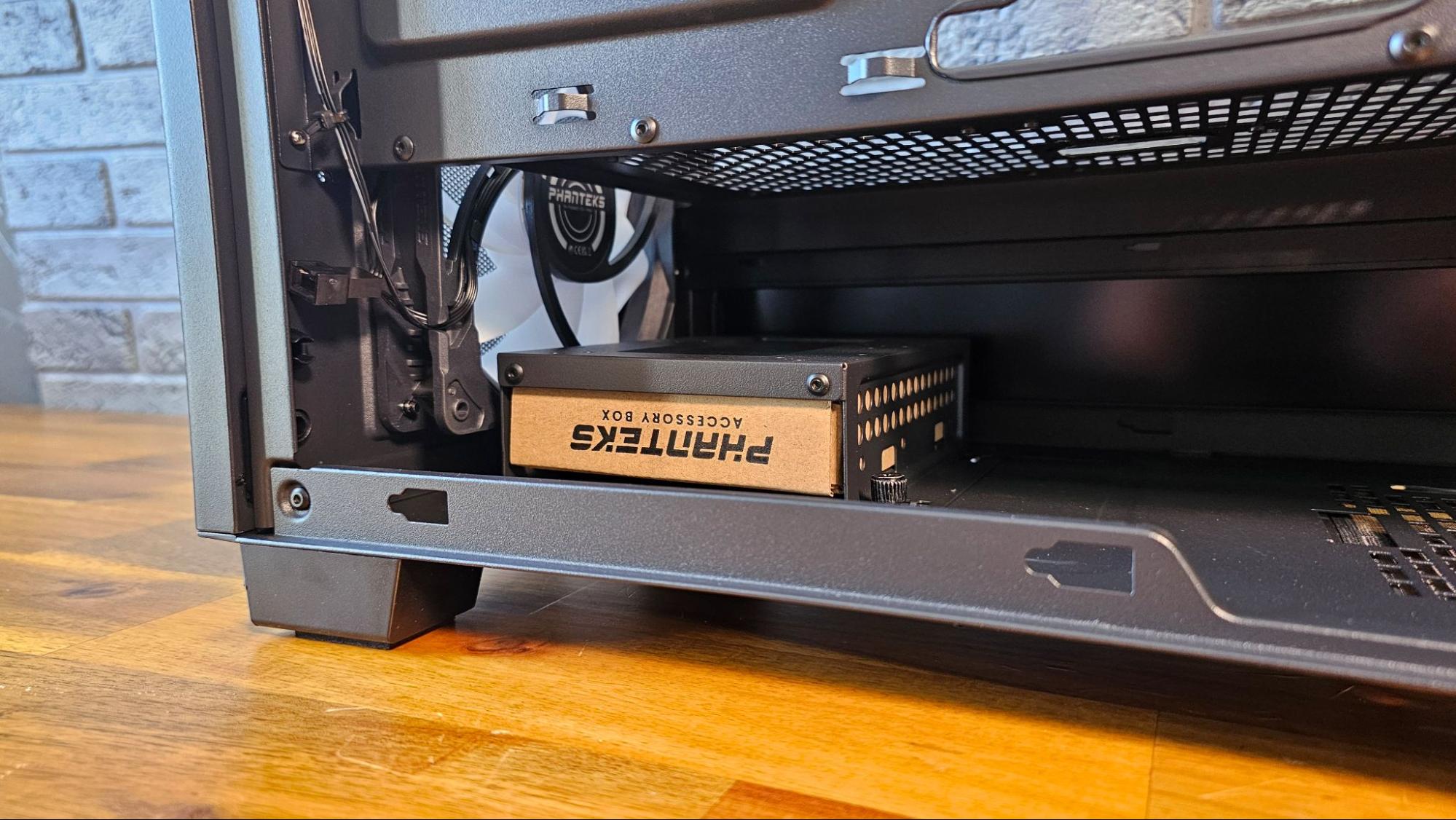
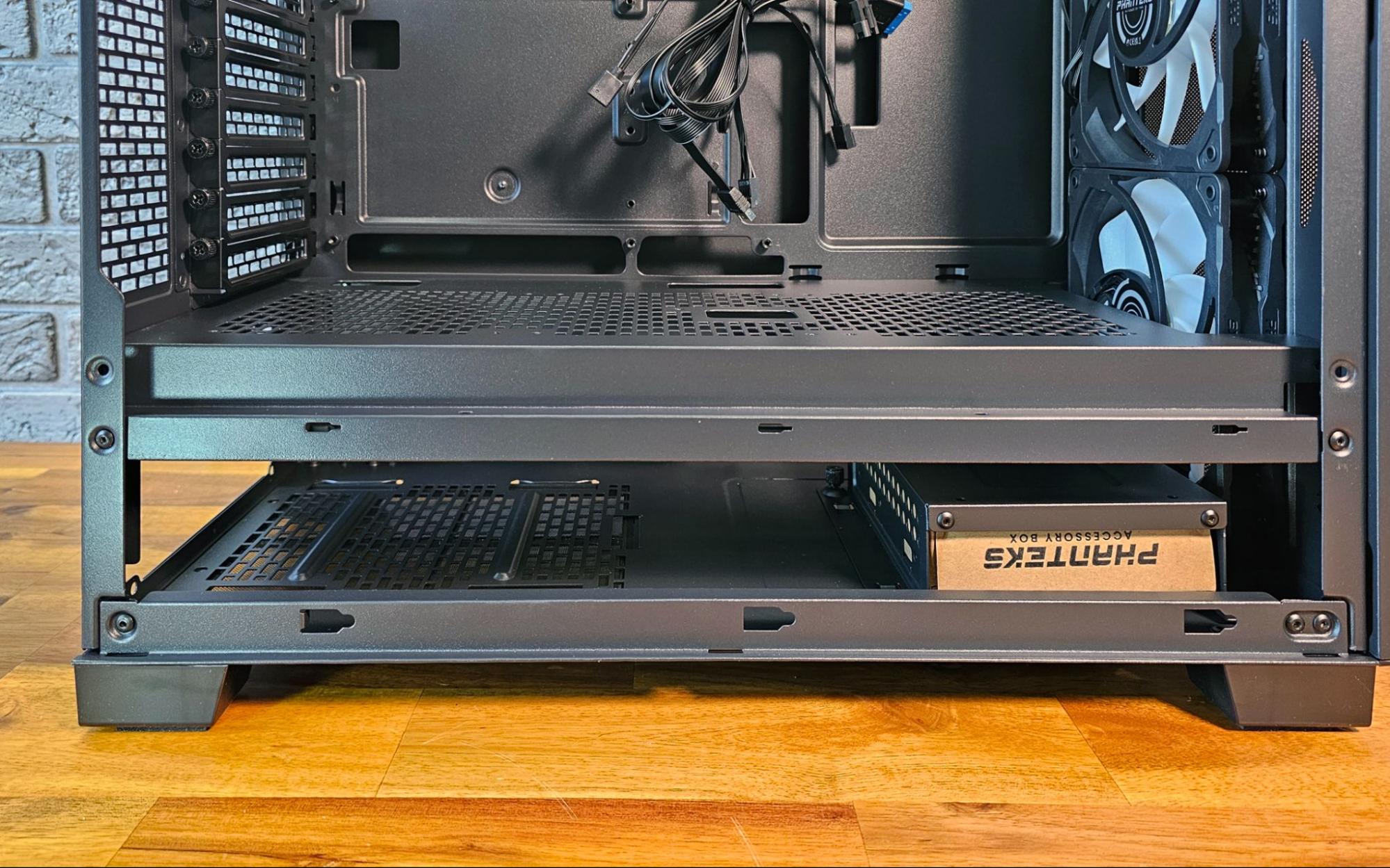
The accessory bundle (pretty basic, with screws and an unnecessary amout of plastic zip ties) is housed in the case's sole 3.5-inch drive tray, held on by slots and a single thumb screw. If you don't have a 3.5-inch drive, you can install a pair of 2.5-inch drives here. Three more 2.5-inch drives can be mounted housed horizontally on a removable bracket behind the CPU socket.
Get Tom's Hardware's best news and in-depth reviews, straight to your inbox.
Behind the motherboard area, you can see the plethora of cutouts for rear-connector motherboards, as well as the more typical cable cutouts. Again, note the lack of any kind of rubber coverings around the holes. I mostly didn't miss them, but if you're trying to hide every cable possible, they would have been helpful on that front.
One thing I did very much appreciate, is that Phanteks ships the case with the cables for all four of the fans pre-routed and daisy chained together. This made the build process quite a bit easier. Note that the bottom PSU area is completely open, so you could install extra long power supplies with relative ease – especially if you remove the 3.5-inch drive tray. But I was able to install Be Quiet's 1500W Straight Power 12 (which is pleasingly compact for its wattage, at just over 7 inches long) in this case without removing the drive tray.
Phanteks XT Pro Ultra Build
As I usually do (or at least try to do), I began the Phanteks XT Pro Ultra build by removing all of the case's panels. Most of that was easy, though I had issues getting the front off until I realized if you pull from under the Phanteks logo on the bottom, it pops right off.
For the sake of simplicity (and testing out this case's rear-connector features) I used the same motherboard, CPU, GPU and cooler here as I had installed in the InWin F5 case. That's an MSI Z90 Project Zero motherboard, Core i5-13600K, Gigabyte Radeon RX 7700 XT graphics card, and InWin MR36 360mm AIO.
The build process went more or less how I expected. The one major hiccup was that InWin's 360mm AIO barely fit up top (it is longer than some other 360 AIOs, at 15.63 inches). To get the radiator in, I had to remove the case's top intake fan. But once the cooler was screwed in, re-installing the top fan was simple. Rotating the InWin logo atop the CPU so it's the right way up is also simple. I just forgot to do it before taking this photo.
For those who prefer to show off their graphics card a little more Phanteks, does sell a Gen4 vertical GPU bracket / riser cable combo for about $50. And pretty much any consumer graphics card should fit in this case, as there are seven expansion slots and a little over 15 inches of space from the brackets to the front fans. For those looking to install one of the best air coolers, there is about seven inches of clearance from the CPU socket. Note that Phanteks hasn't published official numbers on CPU and GPU clearance (at least that I can find); these are just my estimates using a tape measure.
If you notice, as I did, that the lower PSU area is left open and visible from the front, note that the tempered glass side panel is blacked out near the bottom. So you can't see your power supply or drives when the panel is in place.
Cable considerations
This is the fourth PC build I've done using rear-connector motherboards, and it's clear that there's no good way to make your cables look reasonably neat with these kinds of builds. With the connectors distributed around three edges of the board, the best thing you can generally do is get as many of the wires as possible running along one central area, usually to the left of the motherboard.
Of course, it doesn't help that the Phanteks XT Pro Ultra's cable routing features are essentially just zip ties and tie-down points. Since I'll probably rip this build apart soon after I write this, I mostly used reusable hook-and-loop straps that I came with previous cases I've tested to keep the wires fairly flat against the case.
Interestingly, even though there's less than an inch of clearance between the back of the motherboard area and the where side panel lives when the case it closed, I didn't have as much of an issue with bulging cable slack as I did with MSI's Pano M100R PZ case or the larger InWin F5. Perhaps I'm just getting used to these kinds of builds, or maybe it just felt easier because the first thing I did was use a strap to lash down the primary 24-pin power connector so all its wires weren't trying to stick straight up out of the back of the motherboard.
Whatever the reason, while I'd still love more space behind the XT Pro's motherboard (and all the rear-connector cases I've used so far), there's enough room here for most setups. If you're planning on filing the case up with four or five SATA drives, though, your cable issues might be more of a concern. Hopefully we'll eventually see cases designed specifically for these kinds of motherboards, which are either about an inch wider, or have the motherboard mounting section pushed more toward the glass side of the case. That, though, would also obviously limit your CPU cooler clearance.
It's also worth pointing out that, if you're truly trying to hide as many wires as possible, the XT Pro's lack of grommets around its routing holes means that, if you look close enough, you can see the jumble of cables behind the motherboard. That might be an issue if you're looking to build a truly immaculate showpiece case. But if that's your aim, you might want to consider a higher-end case, anyway.
Dialing in fan speed and noise
Out of the box, I found the Phanteks XT Pro Ultra's fans unnecessarily noisy, both at idle and under load. But once I enabled MSI's Smart Fan settings, the idle noise dropped significantly. And because my AIO was doing its managing CPU thermals under control, I tied the case's fan speeds to the mosfet temperatures rather than the CPU. After that, the case was also reasonably quiet under load, keeping the mosfets around 43 degrees Celsius with the case fans averaging less than 900 RPM during a 10-minute Cinebench run (according to HWinfo). In other words, I'd definitely recommend experimenting with fan settings in the BIOS, both with this case and with every PC build.
Final build and thoughts
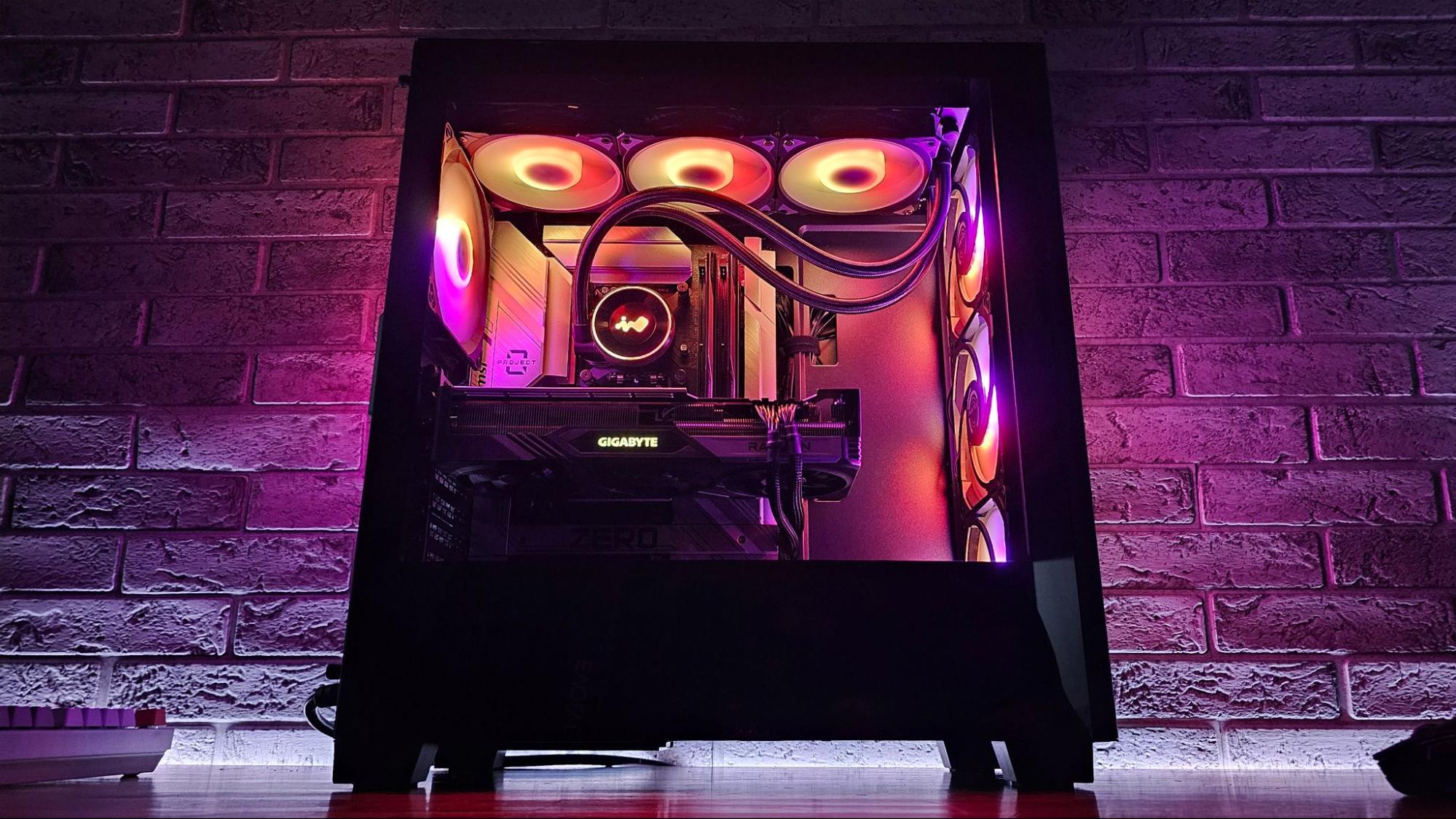

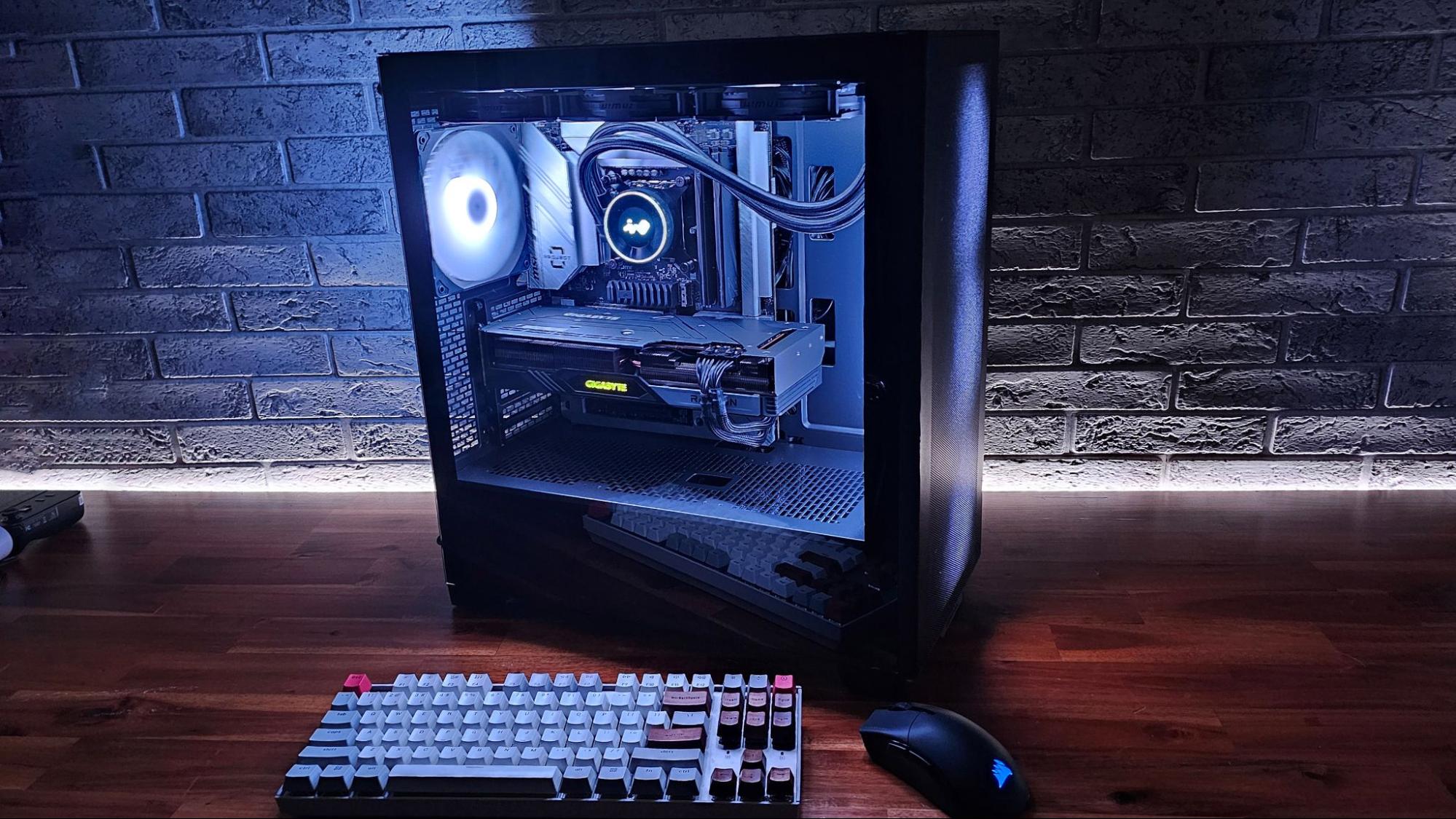
What the Phanteks XT Pro Ultra delivers for around $80 is truly impressive, making this case easy to recommend for budget buyers looking for both airflow and RGB. But there are some sacrifices and oddities here that mean you might want to spend a little more. For starters, the front panel, where the majority of the dust is going to collect, doesn't have a removable filter. But if you pull from the handle at the bottom front, it pops off easily enough.
Also, the case is designed to support both the four 140mm fans it ships with, as well as the 120mm spinners on the other models in the XT line. So there are some unsightly mounting brackets visible when looking directly at the front, through the glow of the RGB fans. This is most noticeable when the lights are dim, but generally less visible if you're looking at the case from an angle.
As someone who's often juggling peripherals and external storage, I also don't love that the top of the case has just two USB ports (one USB-C and one USB-A). Phanteks couldn't have saved much by excluding at least a second USB-A port. But again, given the four included RGB fans and other included features for the $80 price, I can't complain too much. At least the metal power and reset buttons here feel premium. If you need more easily accessible ports, maybe consider putting one of the best USB hubs on your desk.
With four attractive and quiet fans (at least after some tweaking) for great airflow, a tempered glass side panel, room for powerful components, and support for the emerging rear-connector motherboard market, all for around $80, the Phanteks XT Pro Ultra is a great budget case. Its toughest competition, perhaps unsurprisingly, also comes from Phanteks – at least for now. The Phanteks Eclipse G360A that we reviewed in 2022 lacks rear-connector motherboard support and "only" comes with three 120mm RGB fans. It also typically sells for around $80. When we wrote this, Newegg was offering the white model just $60 after a $20 rebate for the white model. That's a sweet deal on another great budget case. But a Phanteks rep told us the Eclipse G360A is being phased out, and availability already seems spotty (the black model isn't available on Newegg and neither model is in stock on Amazon). So the XT line seems to be the company's new budget offering. And the XT Pro Ultra is easy to recommend for buyers looking to spend less than $100.
MORE: Best PC Cases
MORE: Best Mini-ITX Cases
After a rough start with the Mattel Aquarius as a child, Matt built his first PC in the late 1990s and ventured into mild PC modding in the early 2000s. He’s spent the last 15 years covering emerging technology for Smithsonian, Popular Science, and Consumer Reports, while testing components and PCs for Computer Shopper, PCMag and Digital Trends.
-
PEnns Correction:Reply
"...Phanteks couldn't have saved much by excluding at least a second USB-A port."
"including". -
wakuwaku ReplyThe steel front sadly lacks a removable filter, which is a shame since that's where the majority of the dust will accumulate.
First time seeing a Phanteks case? Never bothered reading the product page to understand the features of the case you are reviewing? Never did any research from other case manufacturers too?
Here, have a link: https://www.phanteks.com/XT-Pro.html
Phanteks has been using their ultrafine mesh front to filter dust for quite a long time. Adding an additional dust filter will just impede air flow and reduce cooling. Many other case manufacturers i have seen lately have started considering the same strategy.
If you have been using and reviewing the case for lets say a month, then commented on how you wish it had an additional dust filter because the front mesh wasn't filtering enough dust, fine. But you are just doing a hands on. You have no right to comment on the lack of the dust filter when you have no experience or proof showing how effective or ineffective is their solution to the dust problem while reducing airflow resistence in the process.
My brother has a phanteks case with the same front mesh, I helped build the pc for him, and I tested and played with it for around a month before he found free time to take it back with him. I can safely say that their fine mesh works really well as I can see alot of dust accumulating outside the case while the inside stayed relatively dust free during that month. And you can really feel the air move compared to similar cases with a dust filter behind the normal mesh fronts. -
Soaptrail Reply
I don't think the reviewer wanted a second dust filter for the front, merely he wanted the existing dust filter to be removable. I have a be quiet 500DX and it is the same for the front dust filter, it is there but not removable. I have to remove the front of the case to clean it but it only needs to be done twice a year.wakuwaku said:First time seeing a Phanteks case? Never bothered reading the product page to understand the features of the case you are reviewing? Never did any research from other case manufacturers too?
Here, have a link: https://www.phanteks.com/XT-Pro.html
Phanteks has been using their ultrafine mesh front to filter dust for quite a long time. Adding an additional dust filter will just impede air flow and reduce cooling. Many other case manufacturers i have seen lately have started considering the same strategy.
If you have been using and reviewing the case for lets say a month, then commented on how you wish it had an additional dust filter because the front mesh wasn't filtering enough dust, fine. But you are just doing a hands on. You have no right to comment on the lack of the dust filter when you have no experience or proof showing how effective or ineffective is their solution to the dust problem while reducing airflow resistence in the process.
My brother has a phanteks case with the same front mesh, I helped build the pc for him, and I tested and played with it for around a month before he found free time to take it back with him. I can safely say that their fine mesh works really well as I can see alot of dust accumulating outside the case while the inside stayed relatively dust free during that month. And you can really feel the air move compared to similar cases with a dust filter behind the normal mesh fronts.

